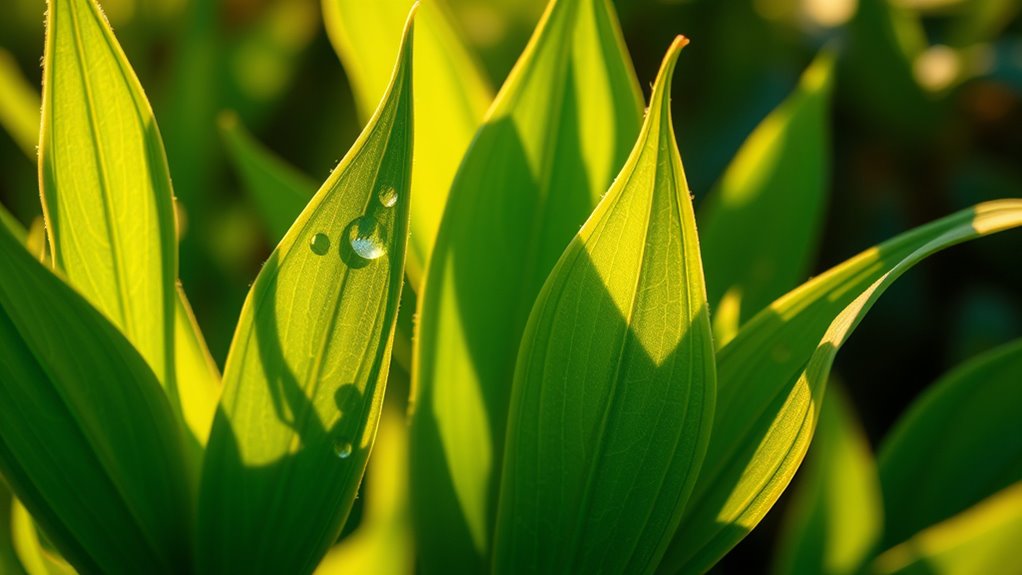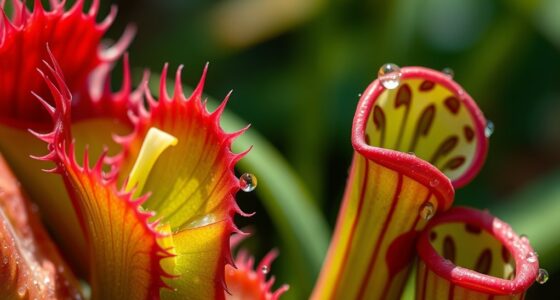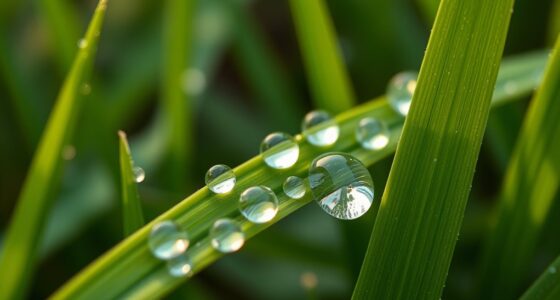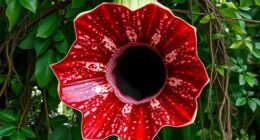Your plant’s circadian clock helps synchronize crucial processes like photosynthesis, growth, and nutrient uptake with the natural day-night cycle. By timing these activities, plants maximize energy use, guarantee healthy development, and reduce stress from environmental changes. Proper synchronization boosts flowering, seed production, and resilience against pests and weather. Understanding why accurate timing matters can open healthier, more productive plants, and there’s always more to discover about how this internal clock works.
Key Takeaways
- Circadian clocks align plant activities with day-night cycles, optimizing processes like photosynthesis and growth.
- Proper timing ensures gene expression for development occurs during favorable environmental conditions.
- Synchronization enhances nutrient uptake, hormone regulation, and flowering, promoting healthy growth.
- Disruptions in circadian rhythms can lead to irregular growth patterns and increased stress susceptibility.
- Environmental cues like light intensity improve internal clock accuracy, boosting overall plant vitality.

Plants have an internal timekeeping system known as the circadian clock that regulates their daily biological processes. This internal clock helps plants anticipate changes in their environment, such as light and temperature fluctuations, so they can prepare accordingly. When you think about it, this timing system is essential for optimizing growth, reproduction, and survival. It’s not just about responding to immediate cues but about predicting what’s coming next, giving plants a competitive edge in their ecosystem.
You might notice that plants open their leaves in the morning and close them at night. That’s the circadian clock at work, aligning their activities with the day-night cycle. This synchronization ensures that energy-harvesting processes like photosynthesis occur at the most efficient times, maximizing light absorption when the sun is up. If plants didn’t have this internal clock, they might waste resources by opening their stomata when there’s no sunlight or closing them during peak light hours, reducing their ability to generate energy.
Timing also plays a crucial role in how plants grow and develop. For example, certain genes involved in cell division and elongation are expressed at specific times of day, ensuring growth occurs when conditions are most favorable. Your plants might grow taller or produce more flowers if their internal clocks are properly synchronized with their environment. Conversely, disrupting this timing—say, by changing light exposure—can lead to irregular growth patterns or even stress responses that weaken the plant’s overall health.
Moreover, plant circadian clocks influence vital processes like nutrient uptake and hormone production. When these processes are timed correctly, plants can efficiently allocate resources and respond to environmental stimuli. For instance, hormone levels that regulate flowering or seed production are often controlled by the circadian clock, so flowering happens at the right time to maximize pollination success. This precise timing can mean the difference between a thriving plant and one that’s vulnerable to pests, diseases, or unfavorable weather.
Additionally, research shows that the presence of a high contrast ratio in light conditions can enhance the synchronization of these internal clocks, leading to healthier plant development. In essence, understanding the importance of timing in plant biology helps you appreciate how finely tuned these organisms are to their environment. Their internal clocks aren’t just about keeping time but about optimizing every aspect of their life cycle. When you consider how plants synchronize their activities with the natural world, it becomes clear that timing isn’t just a detail—it’s fundamental to their growth and survival.
Frequently Asked Questions
Can Plant Circadian Clocks Be Influenced by Artificial Lighting?
Yes, plant circadian clocks can be influenced by artificial lighting. When you expose plants to specific light wavelengths and schedules, you can alter their internal clocks, affecting growth and flowering. Using grow lights or adjusting light timing helps you optimize their development, especially indoors. Just remember, consistent lighting patterns are key to syncing their biological rhythms, so your plants stay healthy and thrive.
How Do Circadian Rhythms Affect Plant Disease Resistance?
You may notice that circadian rhythms influence your plant’s disease resistance by regulating immune responses. When these rhythms are synchronized with environmental cues, your plants can better activate defenses against pathogens. Disrupting their internal clock, such as through irregular lighting, can weaken their immunity, making them more vulnerable. By maintaining consistent light cycles, you help your plants optimize their defenses, reducing disease risks and promoting healthier growth.
Are Circadian Clocks Different in Annual Versus Perennial Plants?
Yes, circadian clocks differ between annual and perennial plants. You’ll find that annuals often have faster, more synchronized clocks to support rapid growth and reproduction within a single season. Perennials, on the other hand, tend to have more complex or adaptable clocks, helping them survive over multiple years. These differences help each plant type optimize their growth and survival strategies according to their lifecycle and environmental conditions.
What Role Do Circadian Clocks Play in Plant Flowering Timing?
Think of circadian clocks as the master conductors guiding your plant’s flowering schedule. They sync internal processes with day-night cycles, ensuring flowering occurs at the most favorable time. When days get longer or shorter, these clocks adjust gene activity, triggering flowering signals. By keeping this internal time, your plant can flower precisely when conditions are best, maximizing its chances for pollination and success.
Can We Manipulate Plant Clocks to Improve Crop Yields?
Yes, you can manipulate plant clocks to boost crop yields. By adjusting light exposure, temperature, or genetic factors, you influence their circadian rhythms, optimizing growth and flowering times. Techniques like selective breeding or biotechnological methods can enhance these clocks, making plants more resilient and productive under varying conditions. This approach helps you maximize harvests, improve resource use, and adapt crops to different environments more effectively.
Conclusion
Just like a finely tuned orchestra, your plant’s circadian clock keeps everything in harmony, ensuring ideal growth and health. By understanding and respecting this internal timing, you can help your plants thrive, whether through proper watering, lighting, or care. Remember, timing is everything—miss it, and growth may slow or falter. So, treat your plants like a symphony that needs precise rhythm, and watch them flourish as they follow their natural schedule.










